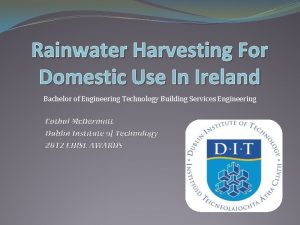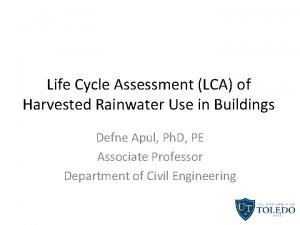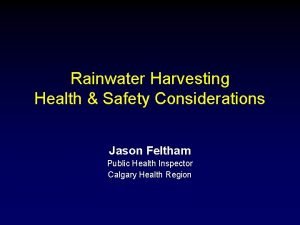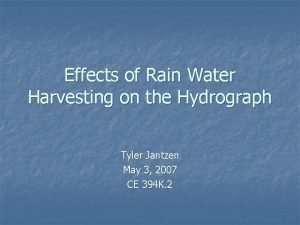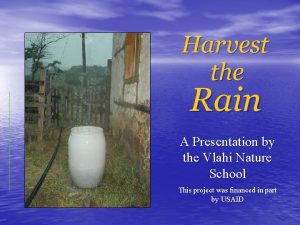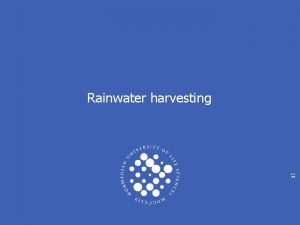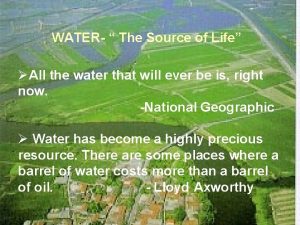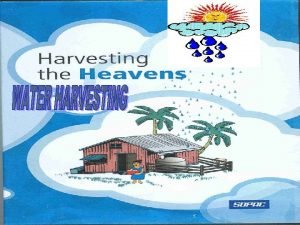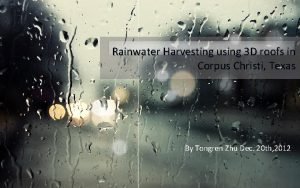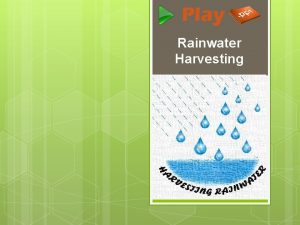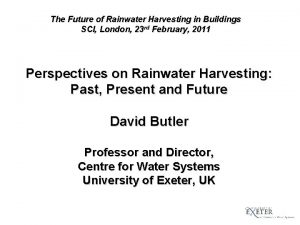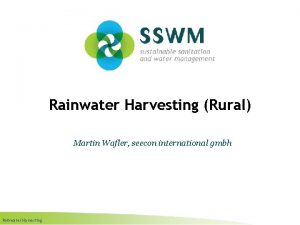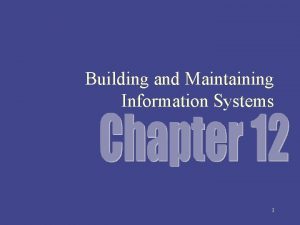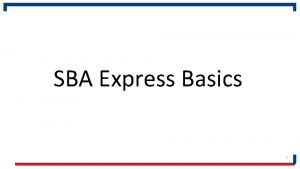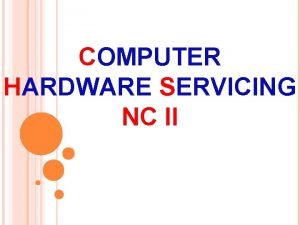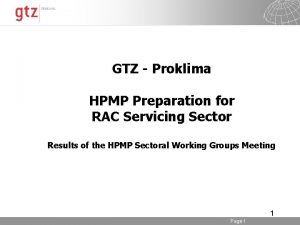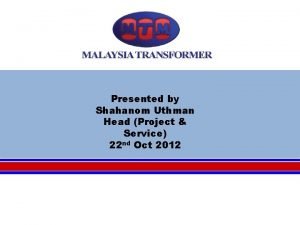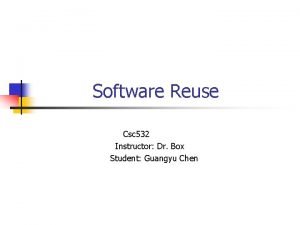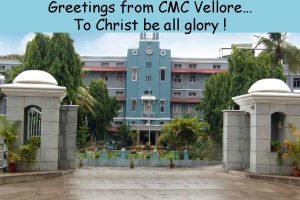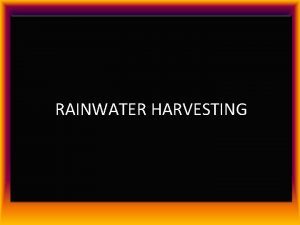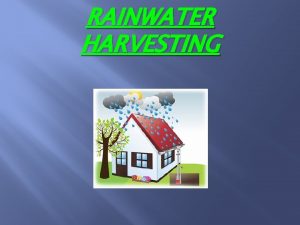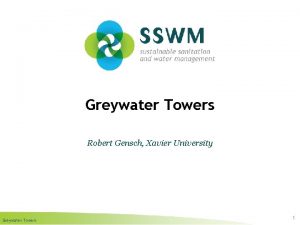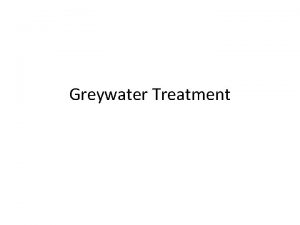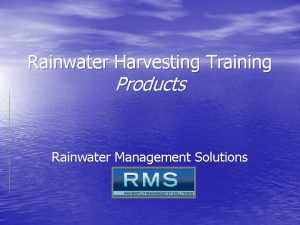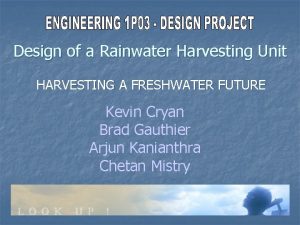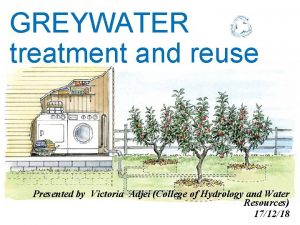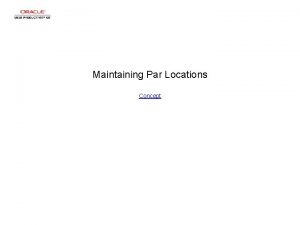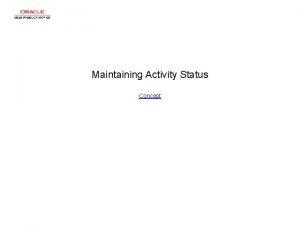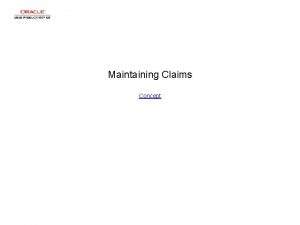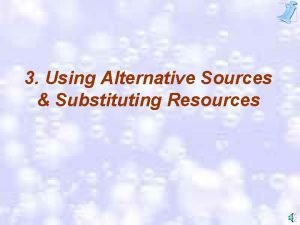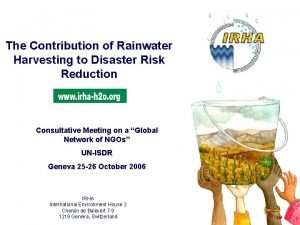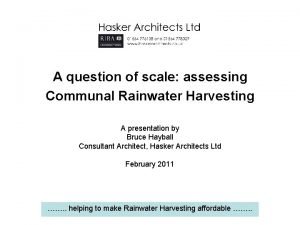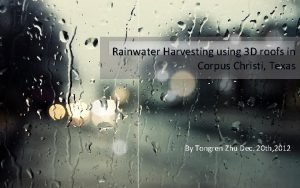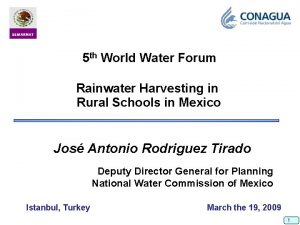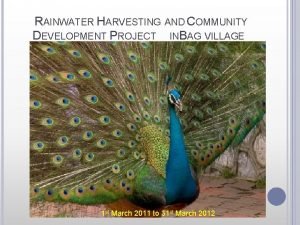Servicing maintaining rainwater harvesting greywater reuse systems Rainwater

























- Slides: 25

Servicing & maintaining rainwater harvesting & greywater reuse systems Rainwater harvesting system Greywater reuse system Inspection, service and maintenance

These sheets will cover: � health and safety considerations � recording requirements for routine inspection, service and maintenance � documentation requirements to enable routine inspection, service and maintenance � frequency of inspection, service and maintenance � typical routine inspection, service and maintenance check requirements � water quality observation, sampling and testing.

Health and safety considerations Key points: � Electrocution/electric shock � Infection � Toxic poisoning � Asphyxiation � Personal injury through equipment handling

Recording requirements for routine inspection, service and maintenance � All routine inspection, service and maintenance activities should be recorded on a routine inspection, service and maintenance record and checklist. � Upon completion of the routine inspection, service and maintenance, a copy of the record should be passed to the customer/end user.

Documentation requirements to enable routine inspection, service and maintenance The typical documentation that needs to be available to enable routine inspection, service and maintenance is: � the system installation handover pack � records of any previous inspection, service and maintenance activities undertaken, including any posthandover inspection, service and maintenance records � a blank routine inspection, service and maintenance record and checklist.

Routine inspection, service and maintenance requirements Where available, all inspection, service and maintenance should be carried out in accordance with manufacturer’s instructions. Where manufacturer’s instructions are unavailable, the following inspection and maintenance activities, which have been derived using BS 8515: 2009 guidance are recommended.

Rainwater harvesting system System area/component Gutters/downpipes Inspection, service and maintenance check/action • No leakage • No blockages • Clean gutters if necessary Filter(s) • Check condition • Clean, if required

Rainwater harvesting system (continued) System area/component Storage tank(s) and cistern(s) Inspection, service and maintenance check/action • No leakage • Adequate support and stability • Internal cleanliness/presence of debris • Covers are correctly fitted • Vents are clear • Overflows are clear

Rainwater harvesting system (continued) System area/component Pump(s) and pump control Inspection, service and maintenance check/action • No leakage • No corrosion • Correctly positioned (submersible pumps) • Adequately supported using anti-vibration mountings (non-submersible pumps) • Manually operate and check performance including a check for no undue noise and vibration • Check charge pressure in pressure vessel

Rainwater harvesting system (continued) System area/component Back-up water supply System control unit Water level gauge Inspection, service and maintenance check/action • Air gaps are maintained • Functional check • No leakage • General functional check • Alarm and warning functions operate correctly • Functional check • The reading corresponds with the actual water level

Rainwater harvesting system (continued) System area/component Wiring Inspection, service and maintenance check/action • Visual inspection for safe condition Pipework • • Labelling and marking No leakage No corrosion Adequate support All point of use and stop valve labelling is in place and in good condition • All pipework marking (where visible) is in place and in good condition

Rainwater harvesting system (continued) Frequency of inspection service and maintenance For most system types, inspection, service and maintenance should be carried out annually. More frequent inspection service and maintenance may be required or specified where: � performance or quality issues arise � the system serves a public building � the users of the system are particularly vulnerable if exposed to contact with contaminated water. Where UV disinfection is included, the UV lamps should be inspected and either cleaned or replaced every 6 months A rainwater harvesting storage tank will typically only require draining and cleaning every 5– 10 years depending upon the stored water quality.

Rainwater harvesting system (continued) Water quality observation, sampling and testing For a well designed, installed and commissioned rainwater harvesting system, frequent water sampling should not be necessary. However, BS 8515: 2009 states that observations for water quality should be made during maintenance visits. Where observation or illness of a system user identifies potential system performance and/or water quality issues, samples should be taken and tests carried out to investigate the cause.

Rainwater harvesting system (continued) Water quality observation, sampling and testing Parameter Guideline values System type Dissolved oxygen in >10% saturation or >1 mg/l O 2 All systems stored rainwater (whichever is least for all uses) Suspended solids Visually clear and free from floating debris for all uses All systems Colour Not objectionable for all uses All systems Turbidity <10 NTU for all uses (<1 NTU if UV disinfection is used)

Rainwater harvesting system (continued) Water quality observation, sampling and testing Parameter p. H Guideline values 5– 9 for all uses Residual chlorine System type Single site and communal domestic systems All systems, where used <0. 5 mg/l for garden watering <2 mg/l for all other uses Residual bromine <2 mg/l for all uses All systems, where used Derived from BS 8515: 2009 guidance

Greywater reuse system System area/component Filters, membranes, biological support media and strainers Inspection, service and maintenance check/action • Check condition • Clean if necessary Biocide, disinfectant or • Check condition and functionality of dosing other consumable unit chemical • Replenish chemical supply if required

Greywater reuse system (continued) System � Klik hier om tekst area/component Storage tank(s) and cistern(s) Inspection, service and maintenance toe te voegen check/action • No leakage • Adequate support and stability • Internal cleanliness/presence of debris • Covers are correctly fitted • Vents and overflows are clear

Greywater reuse system (continued) System area/component Pump(s) and pump control Inspection, service and maintenance check/action • No leakage • No corrosion • Correctly positioned (submersible pumps) • Adequately supported using anti-vibration mountings (non-submersible pumps) • Manually operate and check performance including a check for no undue noise and vibration • Check charge pressure in pressure vessel

Greywater reuse system (continued) System area/component Back-up water supply System control unit Water level gauge Inspection, service and maintenance check/action • Air gaps are maintained • Functional check • No leakage • General functional check • Alarm and warning functions operate correctly • Functional check • Check accuracy of reading

Greywater reuse system (continued) System area/component Wiring Inspection, service and maintenance check/action • Visual inspection for safe condition Pipework • No leakage • No corrosion • Adequate support

Greywater reuse system (continued) System area/component Labelling and marking Inspection, service and maintenance check/action • All point of use and stop valve labelling is in place and in good condition • All storage tanks and cisterns are labelled and marked • All pipework marking (where visible) is in place and in good condition Backwash • Functional check

Greywater reuse system (continued) Frequency of inspection service and maintenance For most system types, inspection, service and maintenance should be carried out annually. More frequent inspection, service and maintenance may be required or specified where: � performance or quality issues arise � the system serves a public building � the users of the system are particularly vulnerable if exposed to contact with contaminated water.

Greywater reuse system (continued) Frequency of inspection service and maintenance (continued) Where UV disinfection is included, the UV lamps should be inspected and either cleaned or replaced every 6 months. A greywater storage tank will typically only require draining and cleaning every 5– 10 years depending on stored water quality.

Water quality observation, sampling and testing Parameter Spray application Non-spray application Testing System type Pressure washing, WC Garden Laundry sprinkler use, car flushing watering washing Turbidity (NTU) <10 N/A <10 BS 1427 All p. H (p. H units) 5– 9. 5 BS 1427 All Residual chlorine (mg/l) <2. 0 <0. 5 <2. 0 BS EN ISO 7393 -2 All <5. 0 0. 0 <5. 0 Blue book All where 218, method used E 10 Residual 0. 0 bromine (mg/l)

Water quality observation, sampling and testing BS 8525: 2010 Clause 6 uses green, amber and red system status descriptors within the interpretation of results guidance. Status Interpretation Green System under control Amber Re-sample to confirm result and investigate system operation Red Suspend use of greywater system until problem is resolved
 Domestic rainwater harvesting
Domestic rainwater harvesting Rainwater harvesting systems cork
Rainwater harvesting systems cork Life cycle assessment of rainwater harvesting
Life cycle assessment of rainwater harvesting Rainwater harvesting calgary
Rainwater harvesting calgary Hypothesis of rainwater harvesting
Hypothesis of rainwater harvesting Conclusion on rainwater harvesting
Conclusion on rainwater harvesting Bibliography for rainwater harvesting
Bibliography for rainwater harvesting Coarse mesh in rainwater harvesting
Coarse mesh in rainwater harvesting Rain water harvesting
Rain water harvesting Droofs
Droofs Rainwater harvesting introduction
Rainwater harvesting introduction Future of rainwater harvesting
Future of rainwater harvesting Function of rainwater harvesting
Function of rainwater harvesting Maintaining information systems
Maintaining information systems Asset servicing solutions
Asset servicing solutions Sla servicing student loans
Sla servicing student loans Milling machine servicing
Milling machine servicing Sba servicing sop
Sba servicing sop Computer hardware servicing nc2
Computer hardware servicing nc2 Rac servicing
Rac servicing Mboh loan servicing
Mboh loan servicing System100k
System100k Hampton mortgage servicing
Hampton mortgage servicing Foto reduce
Foto reduce Advantage of reuse
Advantage of reuse Advantages and disadvantages of dialyzer reuse
Advantages and disadvantages of dialyzer reuse
